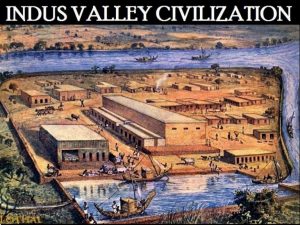Antiquity Of The Indus Civilization – History Notes – For W.B.C.S. Examination.
The Indus Valley Civilization was a cultural and political entity which flourished in the northern region of the Indian subcontinent between c. 7000 – c. 600 BCE.Continue Reading Antiquity Of The Indus Civilization – History Notes – For W.B.C.S. Examination.
Its modern name derives from its location in the valley of the Indus River, but it is also commonly referred to as the Indus-Sarasvati Civilization (after the Sarasvati River mentioned in Vedic sources which flowed adjacent to the Indus) and the Harappan Civilization (after the ancient city of Harappa in the region, the first one found in the modern era). None of these names derive from any ancient texts because, although scholars generally believe the people of this civilization developed a writing system (known as Indus Script or Harappan Script) it has not yet been deciphered.
All three designations are modern constructs, and nothing is definitively known of the origin, development, decline, and fall of the civilization. Even so, modern archaeology has established a probable chronology and periodization:
- Pre-Harappan – c. 7000 – c. 5500 BCE
- Early Harappan – c. 5500 – 2800 BCE
- Mature Harappan – c. 2800 – c. 1900 BCE
- Late Harappan – c. 1900 – c. 1500 BCE
- Post Harappan – c. 1500 – c. 600 BCE
The Indus Valley Civilization is now often compared with the far more famous cultures of Egypt and Mesopotamia, but this is a fairly recent development. The discovery of Harappa in 1829 CE was the first indication that any such civilization existed in India, and by that time, Egyptian hieroglyphics had been deciphered, Egyptian and Mesopotamian sites excavated, and cuneiform would soon be translated by the scholar George Smith (l. 1840-1876 CE). Archaeological excavations of the Indus Valley Civilization, therefore, had a significantly late start comparatively, and it is now thought that many of the accomplishments and “firsts” attributed to Egypt and Mesopotamia may actually belong to the people of the Indus Valley Civilization.
The two best-known excavated cities of this culture are Harappa and Mohenjo-daro (located in modern-day Pakistan), both of which are thought to have once had populations of between 40,000-50,000 people, which is stunning when one realizes that most ancient cities had on average 10,000 people living in them. The total population of the civilization is thought to have been upward of 5 million, and its territory stretched over 900 miles (1,500 km) along the banks of the Indus River and then in all directions outward. Indus Valley Civilization sites have been found near the border of Nepal, in Afghanistan, on the coasts of India, and around Delhi, to name only a few locations.
Between c. 1900 – c. 1500 BCE, the civilization began to decline for unknown reasons. In the early 20th century CE, this was thought to have been caused by an invasion of light-skinned peoples from the north known as Aryans who conquered a dark-skinned people defined by Western scholars as Dravidians. This claim, known as the Aryan Invasion Theory, has been discredited. The Aryans – whose ethnicity is associated with the Iranian Persians – are now believed to have migrated to the region peacefully and blended their culture with that of the indigenous people while the term Dravidian is understood now to refer to anyone, of any ethnicity, who speaks one of the Dravidian languages.
Why the Indus Valley Civilization declined and fell is unknown, but scholars believe it may have had to do with climate change, the drying up of the Sarasvati River, an alteration in the path of the monsoon which watered crops, overpopulation of the cities, a decline in trade with Egypt and Mesopotamia, or a combination of any of the above. In the present day, excavations continue at many of the sites found thus far and some future find may provide more information on the history and decline of the culture.
Discovery & Early Excavation
The symbols and inscriptions on the artifacts of the people of the Indus Valley Civilization, which have been interpreted by some scholars as a writing system, remain undeciphered and so archaeologists generally avoid defining an origin for the culture as any attempt would be speculative. All that can be known of the civilization to date comes from the physical evidence excavated at various sites. The story of the Indus Valley Civilization, therefore, is best given with the discovery of its ruins in the 19th century CE.
James Lewis (better known as Charles Masson, l. 1800-1853 CE) was a British soldier serving in the artillery of the East India Company Army when, in 1827 CE, he deserted with another soldier. In order to avoid detection by authorities, he changed his name to Charles Masson and embarked on a series of travels throughout India. Masson was an avid numismatist (coin collector) who was especially interested in old coins and, in following various leads, wound up excavating ancient sites on his own. One of these sites was Harappa, which he found in 1829 CE. He seems to have left the site fairly quickly, after making a record of it in his notes but, having no knowledge of who could have built the city, wrongly attributed it to Alexander the Great during his campaigns in India c. 326 BCE.
When Masson returned to Britain after his adventures (and having been somehow forgiven his desertion), he published his book Narrative of Various Journeys in Balochistan, Afghanistan and the Punjab in 1842 CE which attracted the attention of the British authorities in India and, especially, Alexander Cunningham. Sir Alexander Cunningham (l. 1814-1893 CE), a British engineer in the country with a passion for ancient history, founded the Archaeological Survey of India (ASI) in 1861 CE, an organization dedicated to maintaining a professional standard of excavation and preservation of historic sites. Cunningham began excavations of the site and published his interpretation in 1875 CE (in which he identified and named the Indus Script) but this was incomplete and lacked definition because Harappa remained isolated with no connection to any known past civilization which could have built it.
In 1904 CE, a new director of the ASI was appointed, John Marshall (l. 1876-1958 CE), who later visited Harappa and concluded the site represented an ancient civilization previously unknown. He ordered the site to be fully excavated and, at about the same time, heard of another site some miles away which the local people referred to as Mohenjo-daro (“the mound of the dead”) because of bones, both animal and human, found there along with various artifacts. Excavations at Mohenjo-daro began in the 1924-1925 season and the similarities of the two sites were recognized; the Indus Valley Civilization had been discovered.
Please subscribe here to get all future updates on this post/page/category/website


 +919674493673
+919674493673  mailus@wbcsmadeeasy.in
mailus@wbcsmadeeasy.in







































































































